The Intel Broadwell Desktop Review: Core i7-5775C and Core i5-5675C Tested (Part 1)
by Ian Cutress on June 2, 2015 7:45 AM ESTProfessional Performance: Windows
Agisoft Photoscan – 2D to 3D Image Manipulation: link
Agisoft Photoscan creates 3D models from 2D images, a process which is very computationally expensive. The algorithm is split into four distinct phases, and different phases of the model reconstruction require either fast memory, fast IPC, more cores, or even OpenCL compute devices to hand. Agisoft supplied us with a special version of the software to script the process, where we take 50 images of a stately home and convert it into a medium quality model. This benchmark typically takes around 15-20 minutes on a high end PC on the CPU alone, with GPUs reducing the time.
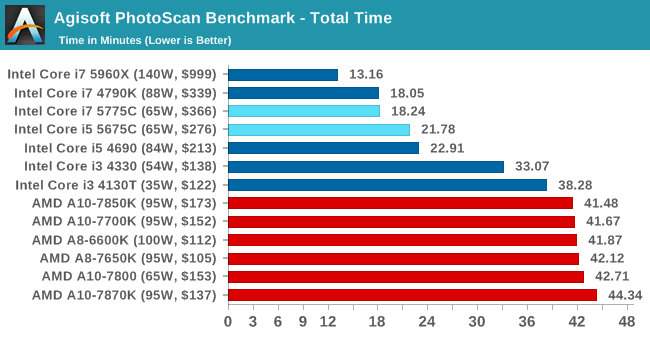
The presence of Crystal Well had a small effect on Photoscan, occurring mostly in the second phase of the calculation which is the one that also has an option to enable the GPU, indicating that memory bandwidth is an potential limitation in that segment.
Cinebench R15
Cinebench is a benchmark based around Cinema 4D, and is fairly well known among enthusiasts for stressing the CPU for a provided workload. Results are given as a score, where higher is better.
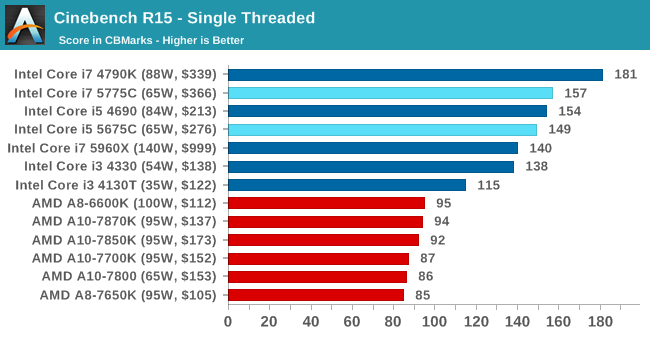
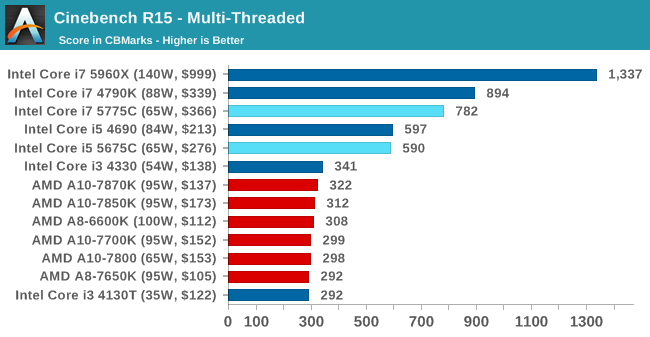
Cinebench is a historically CPU-limited benchmark, and the results show this again here. The fact that the 3.6GHz Broadwell-based i5-5675C performs so closely to the 3.9GHz Haswell-based i5-4690 is a promising sign here, as it means that despite being a mere "tick" in Intel's development efforts, there are tangible IPC increases on the desktop from Broadwell.
HandBrake v0.9.9: link
For HandBrake, we take two videos (a 2h20 640x266 DVD rip and a 10min double UHD 3840x4320 animation short) and convert them to x264 format in an MP4 container. Results are given in terms of the frames per second processed, and HandBrake uses as many threads as possible.
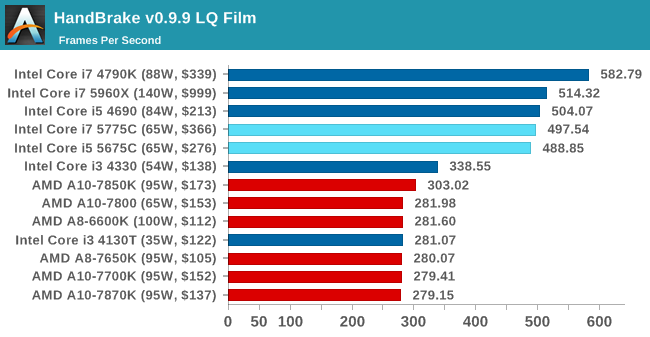

While no obvious improvement was seen in the low quality conversion, the double UHD conversion put the i7 above what was otherwise expected.
Hybrid x265
Hybrid is a new benchmark, where we take a 4K 1500 frame video and convert it into an x265 format without audio. Results are given in frames per second.
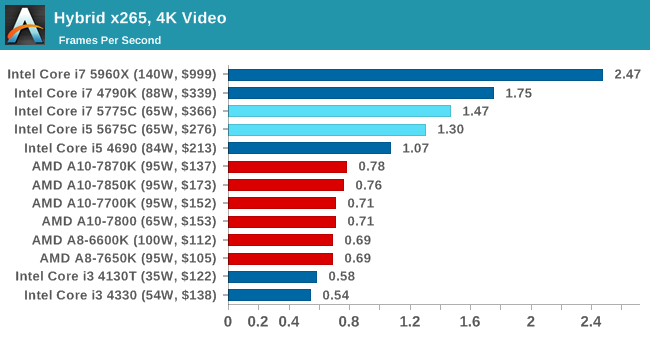
Unlike the Handbrake H.264 tests, the Hybrid x265 tests show a clear uptick in performance on the Broadwell processors. It is not fast enough to catch the i7-4790K and its 4.4GHz turbo clockspeed, but we see the i5-5675C shoot well past the i5-4690 despite the clockspeed deficit. Whether this is due to Broadwell architecture enhancements, Crystal Well acting as an L4 cache, or a combination of the two is difficult to determine, but the end result is substantial.










196 Comments
View All Comments
ryrynz - Wednesday, June 3, 2015 - link
Fairly certain it's 64MB on more than one of them.Ryan Smith - Wednesday, June 3, 2015 - link
All GT3e parts have 128MB of eDRAM. Did we mess up and put the wrong value at some point in this article?patrickjp93 - Thursday, June 4, 2015 - link
No, you're right. 64MB version of Crystalwell is coming to Skylake only as far as I'm aware.Laststop311 - Wednesday, June 3, 2015 - link
Wow Intel wont even let AMD keep the better iGPU performance crown. At least APU's had higher gaming performance going for them. Now they really have nothing. Plus this part uses less power and runs cooler than amd's igpu. Intel's engineering and process advantage is really showing. If I was building an HTPC this chip would be my go to. Can actually play any game with decent settings on it. Turn ur HTPC into a console PC gaming machine as well.The_Assimilator - Wednesday, June 3, 2015 - link
"Now they really have nothing."Couldn't have put it better myself. APUs were AMD's last card, and Intel just took that card out vof AMD's hand. If Zen isn't the second coming that's been promised (and I doubt it because of AMD's marketing track record), then AMD's CPU division is effectively dead.
Oxford Guy - Saturday, June 6, 2015 - link
That's what Anandtech would have people believe. In reality the FX chips like the $100 8320E (I paid $133.75 with an 8 phase power motherboard from Microcenter) is very competitive for things like h.265 encoding, Blender, and so on with Intel -- especially on performance per dollar.So, Anandtech sticks 6 APUs in its charts and not a single 8 thread FX chip.
Oxford Guy - Saturday, June 6, 2015 - link
Example... top scoring APU in Cinebench multithread: 3258 thread FX at just 3.33 GHz: 540
at a more reasonable 4.28 GHz: 683
4.56 GHz: 724
4.78 GHz: 765
kevinkga - Wednesday, June 3, 2015 - link
I love it that you have a Linux section and I was even pleasantly surprised to see Redis benchmarks, which I use a lot! For my purposes I'm investigating using:1. MAXIMUS VII IMPACT MINI-ITX board (because it's the only ITX on the market afaik that supports M.2 x4. Other ITX boards seem to only support M.2 x2 although they often don't make it clear.)
2. Samsung XP941 128GB
3. M350 ITX case
4. Fedora 22 OS
xchaotic - Wednesday, June 3, 2015 - link
"Samsung XP941 128GB" - a bit small I think - best to get 256GB straight away.boozed - Wednesday, June 3, 2015 - link
A salient question perhaps, but I wouldn't go calling it a poignant one.